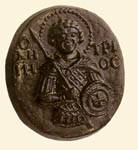|
|
| Byzantine Minor Arts |
13th c. Chelandari Monastery Glass, 3 x 2.3 cm Venice or Thessaloniki |
|

|
This deep blue, nearly circular cameo bears in relief a half-length, frontal portrait of St Demetrios, dressed in military garb. The saint, depicted with short curly hair and a halo indicated by a line of embossed dots, is holding a lance and a round, convex shield marked with a cross. His name is worked in raised letters, while a hint of an A within a circle is all that is left of the abbreviation of the word Άγιος (saint). Three cameos in the British Museum and others in Athens, Paris, Berlin, Bologna, Hamburg, Naples, Cyprus (Nicosia and the Kykkou Monastery), Toronto, Oxford and Washington DC were all produced from the same mould (Byzantine and Post-Byzantine Art 1986, no. 233. Byzantium 1994, no. 204b, p. 190. Byzance 1992, no. 334, pp. 441-2). With close to twenty identical copies known, this is considered the commonest type of glass-paste cameo. To date no cameo in semiprecious stone depicting the saint in a similar iconographic type, that might have served as a model, has been located (Popovic 1983, p. 39). The fact that iconographically its closest counterparts are the representation of St George on a seal belonging to John Comnenos (1057-67) and twelfth- or thirteenth-century jasper cameos (Popovic 1983, p. 40, figs. 36-7 and p. 41 n. 151) supports the assumption that the models for these works are to be sought in earlier Byzantine cameos or seals. One unresolved question is that of their provenance: some (Wentzel 1959, pp. 50-67. Bank 1978, p. 200) ascribe them to Venetian workshops, where, since the sack of Constantinople in 1204, artists in glass had been copying earlier, mid-Byzantine works; while others (Ross 1962, p. 88) hold them to be Byzantine work, given that the art of moulding glass had been practised in Byzantium since the sixth century. The large number of cameos with the same representation of the patron saint of Thessaloniki, in both transparent and opaque glass (Wentzel 1963, pp. 11-24), is an indication not only of the saint's popularity but also of their common provenance. The fact that most such objects were produced as souvenirs for pilgrims visiting the saint's shrine suggests that they may have come from a workshop of Thessaloniki, but it is certainly possible that they were produced in Venice and imported into Thessaloniki for this purpose sometime after the thirteenth century.
| |
|
Bibliography: Radojcic 1955 (1), p. 183, fig. 43. Popovic 1983, pp. 8, 34-43.
| ||
| (K. L-T.) | ||
| Index of exhibits of Monastery of Chelandari 13th century |
||
Reference address : https://www.elpenor.org/athos/en/e218ci13.asp